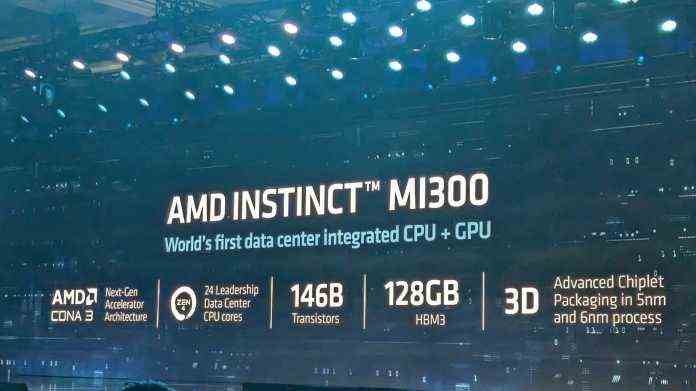During the AMD keynote at CES 2023, CEO Dr. Lisa Su holding up some new chips again. In addition to the Ryzen 7000 for notebooks and the Ryzen 7000X3D for gamers, this time there was also a particularly large combination chip. The Instinct MI300, which is intended in particular for AI calculations, not only combines CPU and GPU on one carrier, but also has space for a generous 128 GB of HBM RAM. AMD also stacks the cores on a layer of cache memory, similar to the X3D models. Makes a total of a whopping 146 billion transistors.
AMD introduced the chip intended for high-performance computing (HPC) six months ago. However, at that time there was only one rendered image to be seen and the vague year of publication 2023. AMD has now specified the date for the second half of the year and held a first physical chip in the camera. The accelerator is currently being tested in the AMD laboratories, but there is still no information about specific clock rates, cache sizes and the like. At least AMD states that the individual chiplets will be manufactured with a structure width of 5 and 6 nanometers, with the cache components probably having a larger width.

AMD reveals a few key data, but final specifications and specific performance data remain vague so far.
The MI300 should be able to perform AI calculations up to eight times faster than its predecessor MI250(X) and also achieve five times the performance per watt. In addition to 24 CPU cores based on Zen 4, the GPU also uses the new CDNA3 architecture. The CDNA GPUs are fully optimized for compute tasks and are not suitable for 3D graphics calculations. Except for the probable relationship to RDNA3, what concrete improvements CDNA3 will bring remains unclear for the time being.
This time, the 128 GB of HBM3 memory is shared between the CPU and GPU, which should bring significant advantages for compute performance – depending on the scenario and the amount of training data. Thanks to the now integrated CPU, the accelerator should be able to run directly without an additional Epyc processor as support, i.e. represent an APU. The next few months will have to show how the mainboard version and compatibility with older systems are.
(asp)

